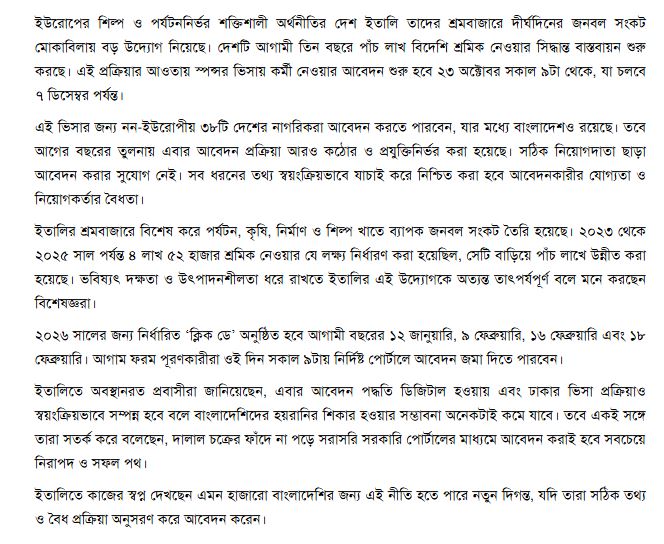
A golden opportunity is unfolding for non-EU nationals. Italy, a cornerstone of the European economy, has officially launched an ambitious plan to welcome nearly half a million foreign workers by 2025. This initiative, known as the “Decreto Flussi,” is Italy’s strategic response to significant labor shortages across key sectors. For thousands of aspiring workers from countries like Bangladesh and 37 other non-EU nations, the Italy Work Permit Visa 2025 represents a life-changing prospect.
This comprehensive guide will walk you through everything you need to know about this massive recruitment drive. We will cover the Decreto Flussi 2023-2025, the specific quotas, the high-demand sectors, the all-important “Click Day” application dates for 2025, the new digital application process, and crucial advice on how to avoid scams.
What is the Decreto Flussi? Understanding Italy’s Immigration Quota System
The “Decreto Flussi” (Flows Decree) is an annual legislative act by the Italian government that sets quotas for the number of non-EU citizens who can enter Italy for work purposes. It is the primary legal channel for obtaining a work permit in the country for specific categories of employment.
Unlike previous years where the decree was announced annually, the Italian government has implemented a three-year plan for 2023-2025. This provides unprecedented predictability for both employers and potential workers. The total quota for this period has been set at a staggering 452,000, which recent reports indicate has been increased to nearly 500,000 to meet escalating demands. This long-term vision is designed to stabilize the labor market and support Italy’s economic growth.
The decree primarily targets two types of work:
- Seasonal Work (Lavoro Stagionale): Typically for sectors like agriculture and tourism, lasting up to nine months.
- Non-Seasonal and Self-Employment (Lavoro Subordinato e Autonomo): For long-term employment in industries such as construction, transport, and manufacturing.
The 2025 Quota: A Massive Opportunity Driven by Economic Need
Italy’s economy is facing a critical challenge: a severe shortage of skilled and unskilled labor. An aging population, coupled with a post-pandemic economic rebound, has left gaping holes in several vital industries. This is why the government’s initiative is not just a policy but a national economic necessity.
High-Demand Sectors for the Italy Work Permit Visa 2025:
The Decreto Flussi specifically targets sectors where the need for workers is most acute. If you have skills or experience in the following areas, your chances of finding a sponsoring employer are significantly higher:
- Agriculture: A perennial need for seasonal workers for harvesting and farming activities.
- Tourism and Hospitality: Hotels, restaurants, and tourist services are booming and require staff, from chefs and waiters to hotel managers and support staff.
- Construction (Edilizia): Italy is undergoing significant infrastructure projects, creating a massive demand for construction workers of all skill levels.
- Road Haulage and Transport: There is a critical shortage of truck drivers and logistics personnel to keep the supply chain moving.
- Manufacturing and Mechanics (Meccanica): Skilled mechanics and factory workers are highly sought after in Italy’s industrial heartlands.
- Telecommunications and IT: The digital transformation requires a steady flow of tech-savvy professionals.
- Care and Social Services: The need for elderly care assistants and home health aides is growing rapidly.
This wide range of sectors means that opportunities exist for a diverse pool of applicants, from manual laborers to specialized technicians.
Key Dates for the Italy Work Permit Visa 2025: Mark Your Calendar for “Click Day”
The application process for the Decreto Flussi is a time-sensitive, digital race against the clock known as “Click Day.” On these specific dates, Italian employers submit pre-filled applications for their chosen workers through an official government portal. The system operates on a first-come, first-served basis, meaning applications submitted within the first few seconds of the portal opening have the highest chance of success.
While the application window for the 2023-2024 quotas has its own schedule, the government has already announced the crucial Click Days for the 2025 intake. Aspiring applicants and their potential employers must be prepared for these dates:
(Note: These dates are typically assigned to different work categories, such as non-seasonal, seasonal, and other specific sectors. Employers should monitor the official portal of the Ministry of the Interior for precise details on which date corresponds to which category.)
The key to a successful Click Day submission is preparation. Employers can pre-fill the application forms on the portal well in advance. On the scheduled Click Day, at exactly 9:00 AM Italian time, they must simply click “submit.”
Who is Eligible? Applicant and Country Requirements
The Decreto Flussi is open to citizens of specific non-EU countries with which Italy has cooperation agreements on migration. The list includes 38 countries, with Bangladesh being a prominent one.
However, the most critical eligibility requirement is not your nationality, but having a valid job offer from an employer based in Italy.
The process is employer-led. This means you, as a potential worker, cannot apply for the visa on your own. An Italian company or employer must first decide to hire you and then initiate the application on your behalf. The employer is your “sponsor” and is responsible for proving to the Italian authorities that they have a genuine need for a foreign worker.
The New Application Process: Digital, Stricter, and More Secure
For 2025, Italy has overhauled its application system to make it more rigorous, transparent, and technology-driven. This is a direct response to past issues with fraud and application backlogs.
Key features of the new process:
- Centralized Digital Portal: All applications must be submitted by the employer through the official Ministry of the Interior’s portal (Portale Servizi ALI).
- Automated Verification: The system now incorporates automated cross-checks. It will instantly verify the employer’s financial solvency, tax compliance, and legal standing. It will also check the applicant’s details against immigration and security databases.
- Mandatory Employer Legitimacy: Only legitimate employers with a demonstrated need and the financial capacity to pay a worker’s salary can successfully apply. This makes it nearly impossible for fake companies or fraudulent agents to manipulate the system.
- Reduced Bureaucracy: By automating verification, the goal is to speed up the issuance of the “Nulla Osta” (no-objection certificate), the most crucial document in the process.
This digital shift is a significant advantage for genuine applicants, as it reduces the potential for harassment and ensures that only valid applications are processed.
Step-by-Step Guide for Aspiring Applicants
Understanding the process is the first step to success. Here is a simplified workflow for anyone dreaming of working in Italy under the 2025 Decreto Flussi:
Step 1: Find a Job and a Sponsoring Employer (The Most Important Step)
This is where your journey begins. You must actively search for a job in Italy.
- How to find a job: Use online job portals (e.g., LinkedIn, Indeed Italy, Info Jobs), connect with professional networks, or directly contact Italian companies in your field.
- Legitimacy is key: Ensure the company is real and the job offer is genuine.
Step 2: The Employer Applies for the Nulla Osta
Once you have a job offer, your employer will gather your documents (like your passport copy) and prepare the application on the Portale Servizi ALI. They will submit this application on the designated “Click Day” for your work category.
Step 3: Receive the Nulla Osta
If the application is successful and falls within the quota, the Italian authorities will issue a Nulla Osta (no-objection certificate). This is the official authorization for you to be hired. Your employer will receive it and send it to you.
Step 4: Apply for the D-Type (National) Work Visa
With the Nulla Osta in hand, you can now apply for your work visa at the Italian Embassy or Consulate in your home country (e.g., the Italian Embassy in Dhaka for Bangladeshi citizens). You will need to submit the Nulla Osta, your passport, the visa application form, and other required documents.
Step 5: Travel to Italy and Apply for the Residence Permit (Permesso di Soggiorno)
Once your visa is approved and stamped in your passport, you can travel to Italy. Within eight days of your arrival, you must apply for a Permesso di Soggiorno (residence permit) at the local post office using a special kit. This permit is your legal document to live and work in Italy.
A Crucial Warning: Avoid Scams and Fraudulent Agents
The high demand for Italian work visas has created a breeding ground for scams. Unscrupulous agents (often called “dalals”) prey on hopeful applicants, making false promises of guaranteed jobs and visas in exchange for large sums of money.
Remember these critical facts to protect yourself:
- You cannot buy a work visa. The entire process is initiated by a real employer in Italy who has a real job for you.
- Do not pay anyone for a job offer. A legitimate employer will not ask you for money to hire you.
- The application is online and submitted by the employer in Italy. Any agent in your home country claiming they can submit the application on your behalf is lying.
- Trust only official sources. Get your information directly from the Italian Ministry of the Interior’s website and the official website of the Italian Embassy in your country.
The safest and most successful path is to secure a genuine job offer through your own efforts and let the employer handle the legal process in Italy.
Conclusion: A New Horizon for Global Workers
Italy’s three-year, 500,000-worker recruitment drive is one of the most significant immigration opportunities in Europe today. The Italy Work Permit Visa 2025 is a gateway to a stable career, a rich culture, and a new life in a G7 nation.
The new, stricter, and digitalized process aims to create a fair and transparent system that benefits both the Italian economy and genuine workers. For the thousands of hopefuls in Bangladesh and beyond, this is a moment of immense potential. By understanding the process, preparing diligently, and following the legal channels, you can turn the dream of working in Italy into a reality. Stay informed, be proactive in your job search, and above all, be cautious of fraudulent schemes. Your future in Italy awaits.

Frequently asked questions (FAQ)
- Can I apply on my own, without an employer?
No. The Italy Work Permit Visa 2025 is employer-driven. Your Italian employer must apply for nulla osta within the quota. - Is knowledge of Italian required?
Not formally for the visa, but basic Italian greatly improves job integration and safety, especially in construction and hospitality. - Can my family join me?
Yes, family reunification is possible after you meet income and accommodation requirements and hold a valid residence permit. Check the local Questura’s guidance. - Can I change jobs after arrival?
Generally yes, but you must respect the terms of your residence permit and follow local procedures for changes. Seek advice from authorized patronati or legal professionals in Italy. - Seasonal vs non-seasonal—what’s the difference?
Seasonal is time-limited (often up to 9 months) for agriculture/tourism. Non-seasonal is longer (1–2 years, renewable) for stable roles in construction, industry, logistics, etc. - What if I’m already in Italy on another permit?
Some categories allow conversion to work permits within quotas. Check current rules and the available conversion quotas. - Are Bangladeshis eligible in 2025?
Yes—Bangladesh is among the 38 eligible non-EU countries for the 2025 intake, provided you have a valid Italian employer sponsor and meet requirements.
Final pre-submission checklist
- Confirm your eligibility (country, clean record, valid passport)
- Secure a legitimate job offer from a compliant Italian employer
- Ensure the employer has pre-filled your nulla osta application correctly
- Prepare all personal documents with necessary translations/legalizations
- Track the exact opening time (Italy time) and plan for the quota rush
- Keep copies of every document and confirmation email
- Attend your visa appointment with complete documentation
- On arrival, sign the residence contract and apply for your permesso within 8 days